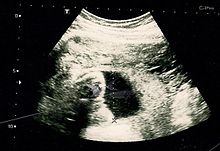Abdominal pregnancy
| Abdominal pregnancy | |
|---|---|
 | |
| A fetus being removed from the abdomen after childbirth in abdominal pregnancy | |
| Specialty | Obstetrics |
An abdominal pregnancy is a rare type of
Because tubal, ovarian and broad ligament pregnancies are as difficult to
Others—in the minority—are of the view that abdominal pregnancy should be defined by a placenta implanted into the peritoneum.[5]
Signs and symptoms
Symptoms may include abdominal pain or vaginal bleeding during pregnancy.[1] As this is nonspecific in areas where ultrasound is not available the diagnosis was often only discovered during surgery to investigate the abnormal symptoms.[1] They are typically diagnosed later in the developing world than the developed.[6] In about half of cases from a center in the developing world the diagnosis was initially missed.[7]
It is a dangerous condition as there can be bleeding into the abdomen that results in
Risk factors
Risk factors are similar to
Mechanism
Primary versus secondary implantation
A primary abdominal pregnancy refers to a pregnancy that first implanted directly in the
Diagnosis
Suspicion of an abdominal pregnancy is raised when the fetal anatomy can be easily felt, or the
Ultrasound

Most cases can be diagnosed by ultrasound.[21] The diagnosis however may be missed with ultrasound depending on the operator's skill.[7][22]
Criteria
To diagnose the rare primary abdominal pregnancy, Studdiford's criteria need to be fulfilled: tubes and ovaries should be normal, there is no abnormal connection (fistula) between the uterus and the abdominal cavity, and the pregnancy is related solely to the peritoneal surface without signs that there was a tubal pregnancy first.[23][24] Studdiford's criteria were refined in 1968 by Friedrich and Rankin to include microscopic findings.[25]
Differential diagnosis
Depending on
Treatment
Ideally the management of abdominal pregnancy should be done by a
Advanced abdominal pregnancy
Advanced abdominal pregnancy refers to situations where the pregnancy continues past 20 weeks of gestation (versus early abdominal pregnancy < 20 weeks).[2][28] In those situations, live births have been reported in the lay press where the babies are not uncommonly referred to as 'Miracle babies'.[29][30] A patient may carry a dead fetus but will not go into labor. Over time, the fetus calcifies and becomes a lithopedion.[31]
It is generally recommended to perform a laparotomy when the diagnosis of an abdominal pregnancy is made.
Babies of abdominal pregnancies are prone to
Once the baby has been delivered placental management becomes an issue. In normal deliveries the contraction of uterus provides a powerful mechanism to control blood loss, however, in an abdominal pregnancy the placenta is located over tissue that cannot contract and attempts of its removal may lead to life-threatening blood loss. Thus blood transfusion is frequent in the management of patients with this kind of pregnancy, with others even using tranexamic acid and recombinant factor VIIa, which both minimize blood loss.[1][34]
Generally, unless the placenta can be easily tied off or removed, it may be preferable to leave it in place and allow for a natural regression.
Outcome with abdominal pregnancy can be good for the baby and mother, Lampe described an abdominal pregnancy baby and her mother who were well more than 22 years after surgery.[38]
Epidemiology
About 1.4% of ectopic pregnancies are abdominal, or about 1 out of every 8,000 pregnancies.
History
Natural experiment
Because pregnancy is outside the uterus, abdominal pregnancy serves as a model of human male pregnancy or for females who lack a uterus, although such pregnancy would be dangerous.[40][41] Abdominal pregnancy has served to further clarify the disease pre-eclampsia which was previously thought (1980s) to require a uterus for it to occur, however pre-eclampsia's occurrence in abdominal pregnancy (with the conceptus outside the uterus) helped throw light on pre-eclampsia's etiology.[42] Cases of combined simultaneous abdominal and intrauterine pregnancy have been reported.[35][43]
References
- ^ PMID 19053177.
- ^ S2CID 33450770.
- .
- PMID 18313451.
- PMID 18639214.
- ^ PMID 20509789.
- ^ S2CID 9781858.
- ^ PMID 11177167. Retrieved January 25, 2009.
- PMID 19625718.
- ^ PMID 3822281.
- ^ Bonn University. Archived from the originalon 2009-04-06. Retrieved 2010-01-25.
- PMID 19936121.
- S2CID 27961263.
- S2CID 27030055.
- PMID 850582.
- ^ .
- PMID 28735570.
- PMID 23302289.
- PMID 16488208.
- S2CID 37719477.
- ^ ISBN 9780781769372.
- ^ S2CID 32321948.
- .
- ISBN 9780781768054.
- PMID 5646396.
- PMID 24127374.
- PMID 10365569. Archived from the original(PDF) on 2010-08-11. Retrieved 2013-01-01.
- ^ S2CID 28498724. Archived from the originalon 2011-07-14.
- ^ BBC News Health. "Doctors hail 'miracle' baby", BBC News, London, 10 September 1999. Retrieved on 11 November 2014.
- ^ Jessica Salter. "'Miracle baby' who grew outside the womb", The Daily Telegraph, London, 31 August 2008. Retrieved on 11 November 2014.
- PMID 24741475.
- PMID 3281075.
- ^ PMID 8291554.
- PMID 22040324.
- ^ PMID 25337188.
- PMID 12418072.
- PMID 22428571.
- PMID 17353085.
- PMID 11064074.
- ^ Meryl Rothstein. "Male Pregnancy: A Dangerous Proposition", Popular Science, Bonnier Corporation, 31 July 2005. Retrieved on 12 November 2014.
- ^ Dick Teresi. "HOW TO GET A MAN PREGNANT", The New York Times, 27 November 1994. Retrieved on 12 November 2014.
- PMID 3563800.
- PMID 21093142.
